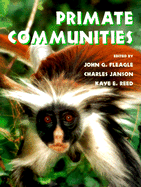Book contents
- Frontmatter
- Contents
- List of contributors
- Preface
- 1 African primate communities: Determinants of structure and threats to survival
- 2 Biomass and use of resources in south and south-east Asian primate communities
- 3 Species coexistence, distribution, and environmental determinants of neotropical primate richness: A community-level zoogeographic analysis
- 4 Primate communities: Madagascar
- 5 Primate diversity
- 6 Phylogenetic and temporal perspectives on primate ecology
- 7 Population density of primates in communities: Differences in community structure
- 8 Body mass, competition and the structure of primate communities
- 9 Convergence and divergence in primate social systems
- 10 Of mice and monkeys: Primates as predictors of mammal community richness
- 11 Comparing communities
- 12 Large-scale patterns of species richness and species range size in anthropoid primates
- 13 The recent evolutionary past of primate communities: Likely environmental impacts during the past three millennia
- 14 Resources and primate community structure
- 15 Effects of subsistence hunting and forest types on the structure of Amazonian primate communities
- 16 Spatial and temporal scales in primate community structure
- 17 Primate communities in Africa: The consequences of long-term evolution or the artifact of recent hunting?
- 18 The future of primate communities: A reflection of the present?
- 19 Concluding remarks
- Systematic index
- Subject index
8 - Body mass, competition and the structure of primate communities
Published online by Cambridge University Press: 21 August 2009
- Frontmatter
- Contents
- List of contributors
- Preface
- 1 African primate communities: Determinants of structure and threats to survival
- 2 Biomass and use of resources in south and south-east Asian primate communities
- 3 Species coexistence, distribution, and environmental determinants of neotropical primate richness: A community-level zoogeographic analysis
- 4 Primate communities: Madagascar
- 5 Primate diversity
- 6 Phylogenetic and temporal perspectives on primate ecology
- 7 Population density of primates in communities: Differences in community structure
- 8 Body mass, competition and the structure of primate communities
- 9 Convergence and divergence in primate social systems
- 10 Of mice and monkeys: Primates as predictors of mammal community richness
- 11 Comparing communities
- 12 Large-scale patterns of species richness and species range size in anthropoid primates
- 13 The recent evolutionary past of primate communities: Likely environmental impacts during the past three millennia
- 14 Resources and primate community structure
- 15 Effects of subsistence hunting and forest types on the structure of Amazonian primate communities
- 16 Spatial and temporal scales in primate community structure
- 17 Primate communities in Africa: The consequences of long-term evolution or the artifact of recent hunting?
- 18 The future of primate communities: A reflection of the present?
- 19 Concluding remarks
- Systematic index
- Subject index
Summary
INTRODUCTION
Understanding the processes influencing the distribution and abundance of organisms and their adaptations is a prime goal in ecology (Krebs, 1994). Although a community approach has been applied to primates for some time, most of the comparisons have been regionally restricted (Charles-Dominique, 1977; Struhsaker & Leland, 1979; Gautier-Hion, 1980; MacKinnon & MacKinnon, 1980; Mittermeier & van Roosmalen, 1981; Terborgh, 1983; Ganzhorn, 1989). A more global perspective of primate ecology was initiated in the 1980s with intercontinental comparisons of whole primate communities (Bourlière, 1985; Terborgh & van Schaik, 1987; Reed & Fleagle, 1995; Fleagle & Reed, 1996; Wright, 1997) and comparisons of primate and other mammalian radiations (Smith & Ganzhorn, 1996; Wright, 1996; Emmons, chapter 10, this volume).
In 1996, Fleagle and Reed used multivariate techniques to quantify and visualize a ten-dimensional niche space of primate species from eight different communities. The niche dimensions were based on body mass, activity cycle, locomotion and diet. According to this analysis, primate communities in the Old World show similar ecological diversity and occupy similar space in the ten-dimensional hypervolume, while the neotropical primate communities show lower overall diversity than the communities on other continents. Thus, the ecological space filled by primates in the neotropics is smaller than in other regions due to the lack of folivores, the lack of species with very large body mass, and the lack of a diverse set of nocturnal species among New World primates (Terborgh & van Schaik, 1987; Kappeler & Heymann, 1996; Wright, 1997).
- Type
- Chapter
- Information
- Primate Communities , pp. 141 - 157Publisher: Cambridge University PressPrint publication year: 1999
- 35
- Cited by



